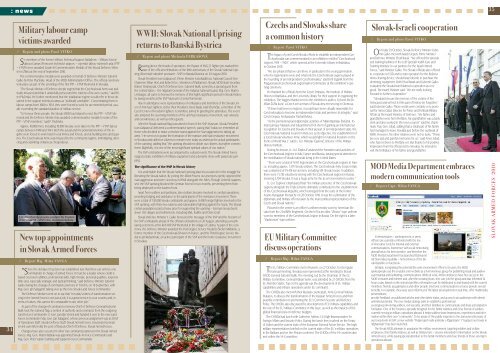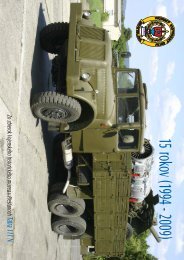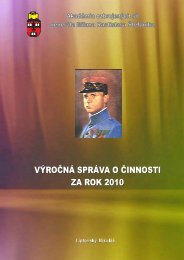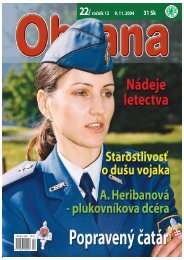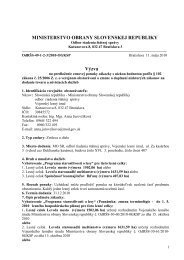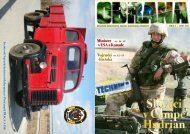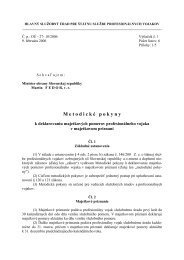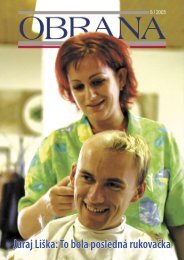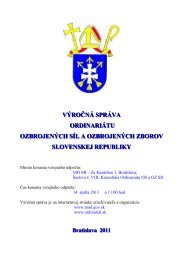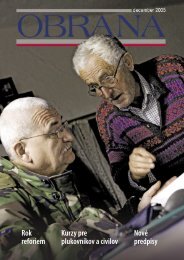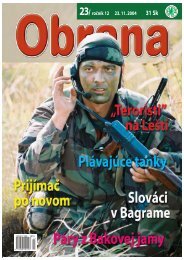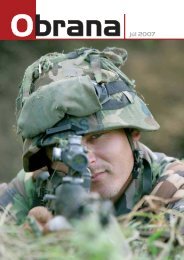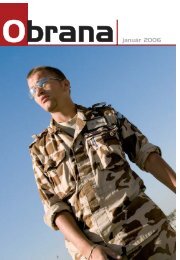Sestava 1
Sestava 1
Sestava 1
- No tags were found...
You also want an ePaper? Increase the reach of your titles
YUMPU automatically turns print PDFs into web optimized ePapers that Google loves.
: news3534Military labour campvictims awarded/ Report and photo Pavol VITKOSix members of the former Military Technical Support Battalions – Military ForcedLabour Camps (Pomocné technické prápory – vojenské tábory nútených prác (PTP– VTNP)) were awarded Grade III Commemorative Medals of the Slovak Defence Ministerin Žilina at the end of September 2010.The commemorative medals were awarded on behalf of Defence Minister ĽubomírGalko by Peter Plučinský, Head of the MOD Administration Office. The official ceremonytook place as part of the unveiling of the first PTP – VTNP Memorial in Slovakia.“The Slovak Ministry of Defence deeply regrets that the Czechoslovak Army was politicallymisused and that it unlawfully persecuted the citizens of its own country,” said PeterPlučinský. He further mentioned that the totalitarian regime would refer to those detainedin the support technical camps as “politically unreliable“. Concentrating them inlabour camps from 1948 to 1954, they were forced to work for an extended period, usuallyexceeding the standard duration of military service.“To honour these people, the Slovak MOD has helped to erect the PTP – VTNP Memorialand the Defence Minister has awarded commemorative medals to some of thePTP – VTNP members,” said P. Plučinský.Approx. 40,000 men, including 10,000 Slovaks, were taken to the PTP – VTNP labourcamps between 1948 and 1954. Both the actual and the potential enemies of the regimewere forced to work hard in coal mines and forests, and at building sites and quarries.The Czechoslovak Army was misused by the communist regime, intimidating, silencingand exploiting civilians as cheap labour.JUDr. Peter Plučinský presents a medal to the Presidentof the Slovak PTP – VTNP Union, Hviezdoslav Brebuda.New top appointmentsin Slovak Armed Forces/ Report Maj. Milan VANGAince the old days it has been an established rule that there can only be one“Scommander in charge of armed forces. It must be a leader whose credit isbased on proven abilities, professional skills, high morale, personal qualities, responsibilityand, especially strategic and tactical thinking,” said Defence Minister ĽubomírGalko during the change-of-command ceremony in Trenčín, on 10 September, withMaj. Gen. Ján Salaganič taking over as the new Slovak Land Forces Commander.The Defence Minister went on to say that “in today’s times of transformation servingin the Armed Forces is not just a job, it is a great service to your country and, interms of values, this cannot be comparable to any other job.”As part of the change-of-command ceremony Chief of Defence General ĽubomírBulík took the national flag, a symbol of authority and command, from the outgoingLand Forces Commander Lt. Gen. Jaroslav Vývlek and handed it over to the new LandForces Commander Maj. Gen. Ján Salaganič, whose previous assignment was as Chiefof Operations Staff, Slovak Defence Staff, Slovak Armed Forces. Lieutenant GeneralVývlek currently holds the post of Deputy Chief of Defence, Slovak Armed Forces.Changes have also occurred in other top command positions in the Slovak ArmedForces: Maj. Gen. Martin Babiak was appointed Slovak Air Force Commander andMaj. Gen. Peter Vojtek Training and Support Forces Commander.WWII: Slovak National Uprisingreturns to Banská Bystrica/ Report and photo Michaela FARKAŠOVÁRoaring above the heads of spectators, the flypast of MiG 21 fighter jets marked thestart of the official celebrations of the 66th anniversary of the Slovak National Uprising(Slovenské národné povstanie - SNP) in Banská Bystrica on 29 August 2010.Slovak President Ivan Gašparovič, Prime Minister Iveta Radičová, National Council Vice-Chairmen Milan Hort and Róbert Fico, Members of Parliament, Slovak MOD State SecretaryRóbert Ondrejcsák, Chief of Defence Gen. Ľubomír Bulík, joined by a special guest fromthe United States – the Adjutant General of the Indiana National Guard, Maj. Gen. MartinUmbarger, all came to honour the memory of this highly significant period in Slovak historyby laying wreaths at the SNP Museum’s Central Memorial.Also in attendance were representatives of embassies and members of the Slovak Unionof Anti-Nazi Fighters, led by their President, Pavol Bada. Vasil Chymčák, a member of theCzech Union of Freedom Fighters’ Committee joined in greeting the attendees. The eventalso attracted the surviving members of the anti-Nazi resistance movement, war veteransand eyewitnesses, as well as other guests.After the Slovak national flag was raised in front of the SNP Museum, Slovak PresidentIvan Gašparovič delivered a commemorative speech, saying that “today we remember allthose who decided to make a resolute stand against the Nazi aggression by taking uparms.” He went on to praise the formation of the massive anti-Nazi resistance movementin Slovakia and called on citizens to remain even today as united as the actual participantsof the uprising, adding that “the uprising should not divide our citizens, but rather connectthem. Rightfully, it is one of the most significant spiritual values of our nation.”The SNP celebrations were accompanied by cultural events. The Slovak Armed Forcesstaged a static exhibition of military equipment and a dynamic show with parachute jumping.The significance of the SNP in Slovak historyIt is undeniable that the Slovak National Uprising played a crucial role in the struggle forliberating the Slovak nation. By joining the Allied Powers our ancestors openly opposed theNazi aggression and were victorious in WWII alongside the Allies. Though violently suppressed,the SNP uprising blocked the German forces for two months, preventing them frombeing deployed on the Eastern Front.Apart from soldiers and partisans, also civilians became involved in combat operations,providing lodging and assistance to the participants of the resistance movement. Therewere a total of 130,000 Slovak combatants and approx. 8,400 foreign fighters involved in theSNP uprising, with thirty-two nations and nationalities fighting against the Nazis. The Slovakcivilian population paid a heavy price for supporting the uprising – German troops burntdown 102 villages and settlements, including Kľak, Kalište and Ostrý Grúň.Slovak Defence Minister Ľ. Galko honoured the message of the SNP and the heroism ofthe SNP combatants ahead of the official celebrations on 20 August, attending a wreathlayingceremony at the Roh Hill SNP Memorial in the village of Lubina. As part of the ceremony,the Defence Minister awarded the First Degree Service Medal to Štefan Miklánek, aformer member of the Czechoslovak Division in France, and the Third Degree Service Medalto Ján Rubaninský, an active participant of the SNP and the home resistance movementin Slovakia.Czechs and Slovaks sharea common history/ Report Pavol VITKOThe legacy of joint Czech-Slovak efforts to establish an independent Czechoslovakiawas commemorated in an exhibition entitled “CzechoslovakLegions: 1914 – 1920“, which opened at the University Library in Bratislava,in October 2010.“We are pleased that we can show, in particular to the young generation,who the legionnaires were and what role the Czechoslovak Legions played inthe founding of an independent Czechoslovakia,” said Emil Cigánik from thePrague-based Czechoslovak Legionnaires Community at the exhibition’s openingceremony.He thanked the officials from the Czech Embassy, the Institute of MilitaryHistory in Bratislava, and the University Library for their support in organising theexhibition. The biggest thanks went to the exhibition’s author, Colonel MUDr.Milan Žuffa Kunč, a Czech serviceman of Slovak descent serving in Olomouc.“If there had been no legions, it would have been virtually impossible forCzechoslovakia to become an independent state and preserve its integrity,” saidCzech Deputy Ambassador Michal Ryšavý.“As the promotional and diplomatic activities of Milan Rastislav Štefánik, TomášGarrique Masaryk and Eduard Beneš fell short of gaining an internationalrecognition for Czechs and Slovaks in their pursuit of an independent state, theCzechoslovak National Council in Paris set, as its objective, the establishment ofa Czech-Slovak Volunteer Army, which would fight for national freedom on thefronts of World War I,” said Lt. Col. Miloslav Čaplovič, Director of the MilitaryHistory Institute.During his lecture, Lt. Col. Čaplovič analysed the formation and activities ofthe Czechoslovak Legions in Italy, France and Russia, paying special attention tothe mobilisation of Slovak nationals living in the United States.“There were a total of 9,957 legionnaires in the Czechoslovak Legions in France,including approx. 1,591 Slovak soldiers. The Czechoslovak Army Corps in Italywas comprised of 19,476 servicemen, including 591 Slovak troops. In addition,there were 71,310 volunteers serving with the Czechoslovak Legions in Russia,involving 5,104 Slovaks. It was a huge army for the as yet non-existent country."Lt. Col. Čaplovič emphasized that “the military presence of the CzechoslovakLegions alongside the Triple Entente ultimately contributed to the establishmentof the Czechoslovak Republic, which emerged from the ruins of the formerAustro-Hungarian Monarchy on 28 October 1918. It was the culmination of thediplomatic and military efforts taken by the main political representatives of theCzech and Slovak nations.”Pictured in the centre is an officer’s uniform mostly worn by American Slovaksfrom the 23rd Rifle Regiment. On the left is an older “Zborov“-type uniformworn by members of the Czechoslovak Legion in Russia. On the right is a later“Vladivostok“-type uniform.EU Military Committeediscuss operations/ Report Maj. Milan VANGAThe EU Military Committee met in Brussels, on 27 October, for its regularbi-annual meeting. Slovakia was represented at the meeting by SlovakCHOD General Ľubomír Bulík. The meeting, led by the Chairman of the EUMilitary Committee, General Håkan Syrén, was attended by 27 CHODs from theEU Member States. Top on the agenda was the development of EU militarycapabilities and military operations under EU command.The CHODs also met with their Russian counterpart, Army General NikolayMakarov, to discuss the transformation of the Russian Armed Forces and theirpossible contribution to promoting the EU’s Common Security and DefencePolicy. The CHODs also discussed the development of EU military capabilities andthe role of the EU Military Committee in this issue, as well as the impacts of theglobal financial crisis on defence budgets.The CHODs had lunch with Catherine Ashton, EU High Representative forForeign Affairs and Security Policy. During the lunch they touched on the Treatyof Lisbon and the current state of the European External Action Service. The highmilitary representatives briefed on the current state of the EU’s military operationsin the Balkans and on the African continent. The CHODs of the V4 countries alsomet within the V4 Committee.Slovak-Israeli cooperation/ Report and photo Pavol VITKOOn Friday 29 October, Slovak Defence Minister ĽubomírGalko met with Israeli Deputy Prime Ministerand Defence Minister Ehud Barak. “We offered the specializedtraining facilities of the Lešť Special Health Care andTraining Institute to our partners for the Israeli ArmedForces,” said Minister Galko. The Slovak officials also offeredto cooperate in EOD and to train operators for the Boženamine-clearing device, should Israel decide to purchase thedemining equipment. Both Ehud Barak and Ľubomír Galkoevaluated the Slovak-Israel bilateral cooperation as verygood. The Israeli Minister said: “We are really lookingforward to further cooperation.”“Slovakia honours the memory of the victims of theHolocaust and will not let this part of history be forgotten,”said Ľubomír Galko. Those words were certainly very personalfor Amos Gilad, Director for Policy and Political-MilitaryAffairs at the Israeli Ministry of Defence. “My father andgrandfather were from Piešťany. My grandfather was a bankclerk and also worked in the town council,” said the charismaticMaj. Gen. Gilad, adding that a small part of his familyhad managed to leave Slovakia just before the outbreak ofWWII. However, his other relatives were not so lucky. “Theseare very sad and painful memories for us,” said Amos Gilad,who has not been to Piešťany yet. But thanks to his positiveimpression from his official visit to Slovakia, he intends tovisit the birthplace of his father and grandfather.MOD Media Department embracesmodern communication tools/ Report Capt. Milan VANGACommunicators – spokespersons or pressofficers are currently confronted with the riseof innovative tools for internal and externalcommunications. Experience with social networkingabroad has so far been positive, and therefore theMOD Media Department has launched Ozbrojenésily Slovenskej republiky – Armed Forces of the SlovakRepublic on Facebook.Similarly, recognising the potential the web environment offers to its users, the MODspokespeople use the youtube.com website as a homonymous group for publishing visual and audiovisualmaterial and facilitating communications. While at work, MOD employees have free access to theMOD’s Intranet and Internet and, after the working hours, they can join the group and stay informed 24hours a day. Based on the selected profiles, information can be distributed to and shared with the currentmembers, friends, acquaintances and other people. Electronic communications services provide severalbenefits. For example, they keep users informed of the latest developments in real time; offer multimediapresentations;provide feedback on publicised articles and other latest topics, and access to an auditorium with almostunlimited potential. The new media strategy aims to establish a professionalsocial group (involving soldiers, civil servants, and their families) to communicate and share job-related information.One of the forums is specially designed for the family relatives and close friends of soldierscurrently serving in military operations abroad. It helps soldiers share impressions, experiences and informationwithin their own “community“. To be aware of the public response to the announced increase ofour troop levels in ISAF, a new website “Podporujem naše jednotky v Afganistane“ (“I support our troops inAfghanistan“) has been launched.The Slovak MOD attempts to popularise the military environment, targeting soldiers and civilianemployees, their family relatives, as well as military fans – anyone interested in information on the SlovakArmed Forces, while paying special attention to the family members and close friends of those serving inoperations abroad.SLOVAK ARMED FORCES 2010


